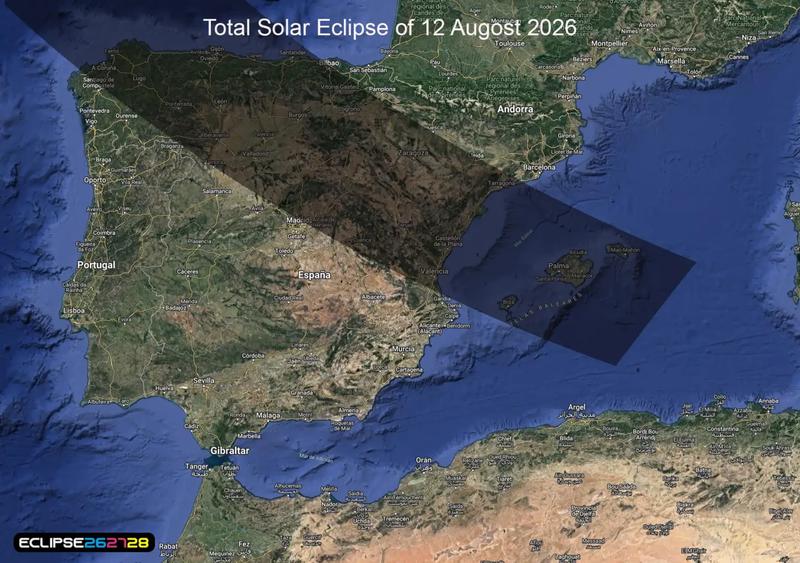August 12, 2026 total solar eclipse - All you need to know, one year out
The cosmic phenomenon will be the first of its kind in mainland Spain in nearly 120 years

August 12, 2026 - mark the date in your calendar. This is the date that a total solar eclipse will be visible in a huge part of Spain, including the southernmost tip of Catalonia.
It's actually the first of a string of three solar eclipses hitting the Iberian Peninsula in 2026, 2027, and 2028; all this after mainland Spain has not seen a total solar eclipse in almost 120 years.
Only the 2026 and 2027 eclipses will be total solar eclipse, while the 2028 will still be a very impressive annular solar eclipse.
An annular solar eclipse occurs when the moon passes perfectly in between the earth and the sun, but at a point when the moon's orbit means it is further away from the earth, therefore its apparent diameter is smaller than the sun's, blocking most of the sun's light, but leaving a ring (annulus) of light surrounding the blocking moon.
Only the 2026 total solar eclipse and 2028 annular eclipse will be visible from Catalonia. The 2027 total solar eclipse will only be visible in the southernmost point of Spain, in cities such as Cádiz and Málaga, as well as large parts of northern Africa.
The 2026 spectacle will be the first in continental Europe since 1999.
In 2027, the eclipse will take place on August 2, while in 2028, the annular "ring of fire" eclipse will occur on January 26.
2026 total solar eclipse
If you live in Barcelona and wish to see this otherworldly phenomenon, your best bet is to get travelling.
The perspective from the Catalan capital will only see the moon cover 99.97% of the sun, but this 0.03% of light will make a huge difference - literally night and day. Therefore, anyone in the position to make a journey and travel some kilometres to be in the path of 100% totality should definitely do so.
The conditions for the 2026 eclipse are ideal for enjoying such a rare astronomical phenomenon.
Taking place in mid-summer, the eclipse coincides with the holiday season. Although the solar altitude during totality will be relatively low—less than 13° above the horizon across the country—early weather models predict clear skies for many regions according to the eclipse website eclipse262728.es, enhancing the viewing experience.
With the sun at such a low altitude at the moment of totality, observing the eclipse will require a clear horizon free of obstructions like buildings, trees, or mountains.
Most total solar eclipses feature a path no wider than 200km, but the 2026’s path will span a hugely impressive 290km, allowing even more people to experience the magic of totality.
In Catalonia, totality will be visible only in the southernmost strip of the territory.
If you were to imagine a line drawn between just north of Lleida and just north of Vilanova i la Geltrú, totality will be visible everywhere south of this line - therefore including the cities of Lleida and Vilanova i la Geltrú.
The sun will also be 100% covered in places like Tarragona, Reus, Salou, Cambrils, the Terres de l'Ebre, and plenty more.
You can check exactly where totality will be visible for the 2026 total solar eclipse in the map below.
Outside of Catalonia, totality will be visible in Galicia, Asturias, Cantabria, the Basque Country, Aragon, La Rioja, Castilla y Leon, half of Madrid, Navarre, Aragon, Castilla-La Manca, Valencia, and the Balearic Islands. In total, around 40% of Spain will witness totality.
Outside of Spain, it will be visible in a tiny strip of northern Portugal, in the north-westernmost corner of the country, as well as in some cities in Iceland and parts of Greenland. And no other land masses in the world.
Airbnb searches up 830% for eclipse week
Holiday rental platform Airbnb has revealed that searches for accommodation on their site have spiked 830% in the areas that will experience totality during that week.
The rural areas of Aragon, Castilla-La Mancha, Catalonia, the Valencian Community, and the Balearic Islands are among the most popular destinations.
The platform has also listed the top ten most-searched destinations for travellers to enjoy the cosmic phenomenon.
- Teruel (Aragón)
- Ariza (Aragón)
- Guadalajara (Castilla-La Mancha)
- Huesca (Aragón)
- Reus (Cataluña)
- Aras de los Olmos (Comunidad Valenciana)
- Valldemossa (Islas Baleares)
- Aliaga (Aragón)
- Arcos de las Salinas (Aragón)
- Daroca (Aragón)